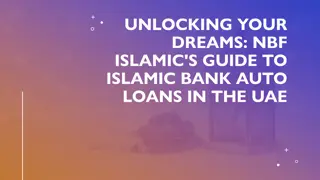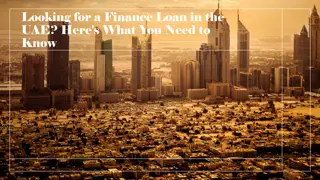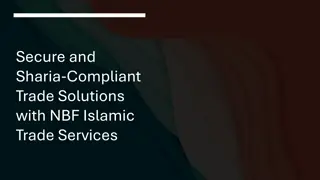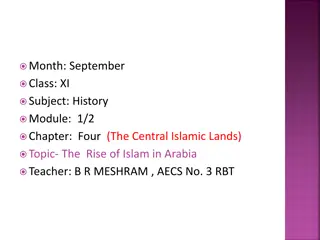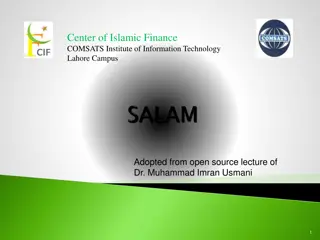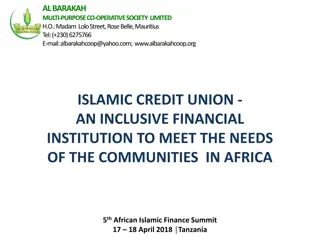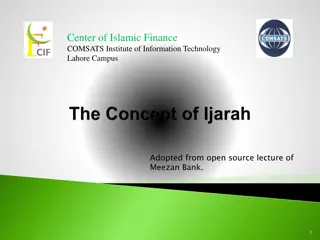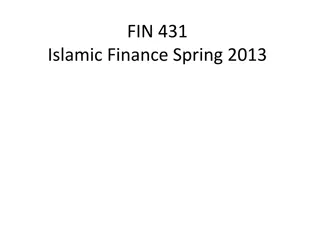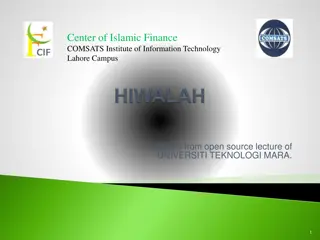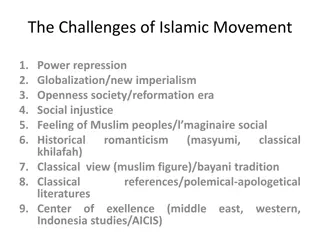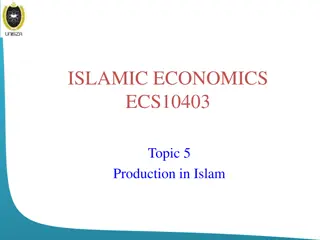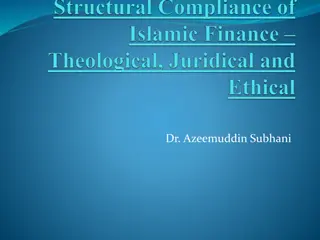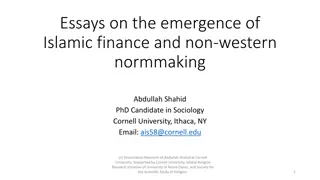Paper 2: Emergence of Islamic Finance
Islamic finance, as a distinct field, emerged in the latter half of the 20th century with the formation of organizations like the OIC and Islamic Development Bank. This paper delves into the characteristics, evolution, and global impact of Islamic finance, highlighting its principles, prohibitions, and growth in assets and adoption worldwide.
Download Presentation

Please find below an Image/Link to download the presentation.
The content on the website is provided AS IS for your information and personal use only. It may not be sold, licensed, or shared on other websites without obtaining consent from the author.If you encounter any issues during the download, it is possible that the publisher has removed the file from their server.
You are allowed to download the files provided on this website for personal or commercial use, subject to the condition that they are used lawfully. All files are the property of their respective owners.
The content on the website is provided AS IS for your information and personal use only. It may not be sold, licensed, or shared on other websites without obtaining consent from the author.
E N D
Presentation Transcript
Paper 2: Emergence of Islamic Finance Abdullah Shahid PhD Candidate in Sociology Cornell University, Ithaca, NY Email: ais58@cornell.edu **The author is conducting further analyses for all the papers in this presentation. Full papers will be available for distribution in Fall 2021. The author is grateful to Prof David Strang, Prof Diane Burton, and Prof Richard Swedberg for their guidance in this project. The author also acknowledges the sincere research assistance of the following Cornell undergraduate students: Annie Fu, Tanmay Bansal, Christopher Elliott, and Shreya Subramanian. (c) Dissertation Research of Abdullah Shahid at Cornell University. Supported by Cornell University, Global Religion Research Initiative of University of Notre Dame, and Society for the Scientific Study of Religion. 1
Context Islam is 1,400 years old. But Islamic finance , Islamic economics as distinct practice/field of study emerged in the 2nd half of the 20th century. Traces of proto-Islamic financial organizations in Egypt and Malaysia. Organized effort to bring back the glory of Islam and its practices occurred through the formation of OIC (Organization of Islamic Cooperation) in 1969. The formation of Islamic Development Bank in 1975 followed from the OIC. (c) Dissertation Research of Abdullah Shahid at Cornell University. Supported by Cornell University, Global Religion Research Initiative of University of Notre Dame, and Society for the Scientific Study of Religion. 2
Characteristics of Islamic Finance DONTs Prohibition of interest No speculation or high uncertainty activities No association with Haram (Islamically prohibited) consumption and production DOs: Instruments, contracts, exchanges Linked to real goods Based on profit-loss / risk sharing / partnership For with Halal (legal, encouraged) consumption and production No coercion; mutual reciprocity of benefits; adequate knowledge; no fraud (c) Dissertation Research of Abdullah Shahid at Cornell University. Supported by Cornell University, Global Religion Research Initiative of University of Notre Dame, and Society for the Scientific Study of Religion. 3
Islamic finance- some basic facts Start Discourses in 1940s; Early trials in 1963 in Egypt, Malaysia. Global Islamic finance assets composition by organizational variety in 2016 1% 3% Islamic banking 17% 1975 Islamic Development Bank, a pan-Islamic financial organization born Sukuk, Bonds Islamic funds Now Assets (2016): US$1.7 trillion Islamic finance organizations (Dec 2017): 80+ countries Use of Islamic finance (Dec 2017): 140 + countries Takaful, Insurance 79% Note: Assets/market size $1.7 tr is based on Deloitte estimate of the assets under management by Islamic financial institution in 2016. It s 50% of UK GDP (5th largest in the world) & the size of private equity assets under management (Prequin estimate) & almost 13% of the market capitalization of New York Stok Exchange. (c) Dissertation Research of Abdullah Shahid at Cornell University. Supported by Cornell University, Global Religion Research Initiative of University of Notre Dame, and Society for the Scientific Study of Religion. 4
Islamic finance what we read in the literature A Saudi Arab Islaimzation project Islamic Development Bank a vehicle of Islamization of economy (Kuran) Religious, cultural hegemony A tool of Islamic revival (Khan, 2015) Extraction in the name of Islam (Fadel, 2008) Capitalist exploitation A fa ade Western capitalism in the guise of Islam (El-Gamal, 2006; Pitluck, 2012) Islamic unity Incoherent pietism (Irfan, 2014) Economic efficiency A non-pragmatic, political financial form that would die out (Kuran, 2004, 2011) (c) Dissertation Research of Abdullah Shahid at Cornell University. Supported by Cornell University, Global Religion Research Initiative of University of Notre Dame, and Society for the Scientific Study of Religion. 5
Research Question Where did Islamic finance emerge earlier? This requires an event history analysis. We need to find the first instance of an Islamic finance organization in each country (assuming country as the unit of analysis). Then, we need to find out why in certain countries the first instance of Islamic finance organization is born earlier than others. (c) Dissertation Research of Abdullah Shahid at Cornell University. Supported by Cornell University, Global Religion Research Initiative of University of Notre Dame, and Society for the Scientific Study of Religion. 6
A conceptual framework of pertinent theories Globalization of markets and Ideas Competition, coercion, imitation The social movement , consumer preference and rational choice explanation of firms are largely ruled out through meta-analysis of existing evidence. Needs to understand the other forces better. State forces Social movement How to study emergence of Islamic finance then? State capacity, Nature of the Economy, Culture, Law Local, global coercive forces Consumer preferences Rational choice of individual firms Efficiency, Risk-Return Demand factors Performative forces once important models are out, they have a life on their own (c) Dissertation Research of Abdullah Shahid at Cornell University. Supported by Cornell University, Global Religion Research Initiative of University of Notre Dame, and Society for the Scientific Study of Religion. 7
Hypotheses Economic Rationality, Economic Capacity, and Financial Development Hypotheses H1: Islamic finance appears earlier in the countries with higher GDP growth. H2: Islamic finance appears earlier in the countries with higher credit rating (i.e., lower credit risk). H3: Islamic finance appears earlier in the countries with developed financial markets and institutions. Legal Environment Hypothesis H4: Islamic finance appears earlier in the common-law origin countries. (c) Dissertation Research of Abdullah Shahid at Cornell University. Supported by Cornell University, Global Religion Research Initiative of University of Notre Dame, and Society for the Scientific Study of Religion. 8
Hypotheses (contd) Cultural Resurgence Hypotheses H5: Islamic finance appears earlier in the former British colony countries. H6: Islamic finance appears earlier in the former British colony countries with common law. H7: Islamic finance appears earlier in the former British colony countries with Sunni over Shia majority. Cultural Compatibility & Variation Hypotheses H8: Islamic finance appears earlier in the Muslim majority countries. H9: Islamic finance appears earlier in countries that have more Sunni than Shia in their Muslim population. H10: Islamic finance appears earlier in the countries with Arabic as an official language. H11: Islamic finance appears later in the countries with English as an official language. H12: Islamic finance appears later in the countries with French as an official language. (c) Dissertation Research of Abdullah Shahid at Cornell University. Supported by Cornell University, Global Religion Research Initiative of University of Notre Dame, and Society for the Scientific Study of Religion. 9
Hypotheses (contd) Geographic Clustering Hypothesis H13: Islamic finance appears earlier in the countries that are geographically closer to Saudi Arabia. Global Influence & Conflict Hypotheses H14: Islamic finance appears earlier in the countries with higher financing from Islamic Development Bank. H15: Islamic finance appears earlier in the countries with lower financing from World Bank. H16: Islamic finance appears earlier in the countries with lower financing from International Monetary Fund (IMF). H17: Islamic finance appears earlier in the countries with high financing from both World Bank and Islamic Development Bank. H18: Islamic finance appears earlier in the countries that vote like Saudi Arabia in the United Nations. H19: Islamic finance appears later in the countries that vote like the United States in the United Nations. (c) Dissertation Research of Abdullah Shahid at Cornell University. Supported by Cornell University, Global Religion Research Initiative of University of Notre Dame, and Society for the Scientific Study of Religion. 10
Data and Methods Identifying the first instance of Islamic finance organization in a country Sources: Google books, Google Scholar, Google Ngram, New York Times, Thomson Reuters, Factiva, Lexis Nexis, and Islamic Finance News country profiles, websites of the federal/central banks of all countries, and Islamic finance competitiveness reports by global consulting firms (e.g., Ernst & Young), ProQuest, Organizational of Islamic Cooperation publications, Islamic Development Bank data and publications, IMF, World Bank, OECD, Oxford encyclopedia. Search terms: Islamic / Islam & country name with : finance , bank , fund , profit sharing , insurance , mutual fund , index funds , and bond . Single search items: sukuk , shariah , sharia , zakat , hajj , pilgrimage . Country specific search terms are also considered (e.g., special finance houses of Turkey). (c) Dissertation Research of Abdullah Shahid at Cornell University. Supported by Cornell University, Global Religion Research Initiative of University of Notre Dame, and Society for the Scientific Study of Religion. 11
Data and Methods (contd) Event history/ duration dependence models Unit of Analysis: Country-year observations, 186 countries in total, year 1975 2016 The first instance earlier than 1975 are considered 1975. Three countries have such instances. Dependent variable: duration (the number of periods/years without any instance of Islamic finance organization) or event(the first instance of Islamic finance organization) Explanatory Variables (lagged by a year to account for endogeneity, as applicable): gdp growth rate, financial development (index from IMF), credit rating (continuous variable), Former British colony (1= the country is a former British colony, 0 = else), common law (1= common law, 0 = else), Muslim majority (1 = the country is Muslim majority, 0 = else), Muslim majority British colony (1= the country is a Muslim majority former British colony, 0 = else), Sunni over Shia (1 = Sunni population > Shia, 0 = else), Arabic as an official language (1= Arabic as official language, 0=else), English as an official language (1= English as official language, 0 = else), French as an official language (1= French as official language, 0=else), Similarity to Saudi Arabia in United Nations voting (continuous measure of cosine similarity), Distance from Saudi Arabia (log transformed continuous distance value), IDB engagement (sum of IDB financing in the country so far, 1+log transformed) World bank engagement (sum of world bank financing in the country so far, 1+log transformed), IMF financing (sum of IMF financing in the county so far, 1+log transformed). Several variables had imputed country-years based on available country years. Details of imputations are available upon request. The author is conducting further analyses for alternative measures of the variables and alternative specifications of the hypothesized relations. So, the results that follow are provisional. (c) Dissertation Research of Abdullah Shahid at Cornell University. Supported by Cornell University, Global Religion Research Initiative of University of Notre Dame, and Society for the Scientific Study of Religion. 12
Results Figure 3: Kaplan Meier survival estimate for the first instance of an Islamic finance organization in a country : comparison between countries (1) that are Islamic Development Bank (IDB) member countries, i.e., idbmember = 1, and (2) that are not IDB member countries, i.e., idbmember = 0. Figure 2: Kaplan Meier survival estimate for the first instance of an Islamic finance organization in a country: comparison between countries (1) that have Sunni over Shia majority in the Muslim population, i.e., sunnimajority = 1, and (2) that do not have Sunni over Shia majority in the Muslim population, i.e., sunnimajority =0. Figure 1: Kaplan Meier survival estimate for the first instance of an Islamic finance organization in a country (c) Dissertation Research of Abdullah Shahid at Cornell University. Supported by Cornell University, Global Religion Research Initiative of University of Notre Dame, and Society for the Scientific Study of Religion. 13
Table 1 Table 1 - - Parametric Regression Model (exponential) Coefficients Parametric Regression Model (exponential) Coefficients Dependent variable: duration (the number of periods/years without any instance of Islamic finance organization) or event(the first instance of Islamic finance organization) Variables Constant Economic & Financial Development Variables GDP Growth Credit Rating Financial Development Legal Environment Hypothesis Legal Origin (1= common law, 0=else) Cultural Resurgence Hypotheses Former British colony (1 = yes, 0 = no) Former British colony countries with common law (1 = yes, 0 = no) Sunni majority former British colony countries (1 = yes, 0 = no) Cultural Compatibility & Variation Hypotheses Muslim majority Sunni over shia majority Arabic as an official language (1 = yes, 0=no) English as an offiical language (1 = yes, 0=no) French as an official language (1= yes, 0= no) Geographic Clustering Hypothesis Distance from Saudi Arabia Global Influence & Conflict Hypotheses Degree of IDB Engagement (financing) Degree of World Bank Engagement (financing) Degree of IMF Engagement (financing) High financing from both World Bank and IDB United Nations voting similarity to Saudi Arabia United Nations voting similarity to USA Model Fit Statistics Model 1 -4.762*** Model 2 -4.829*** Model 3 -5.06*** Model 4 -7.209*** Model 5 -4.759*** Model 6 -3.934*** Model 7 -3.846*** 0.025*** -0.005 1.696* 0.025** -0.005 1.715* 0.025*** -0.001 1.744* 0.012 0.022* 0.021 0.023* 4.059*** 4.927*** 4.843*** 3.963*** 0.119 0.171 -0.369 0.041 0.276 0.05 -0.680 -0.679 0.721*** 0.928* 1.390** 0.736 0.736 2.417*** 0.707* 0.003 0.626 0.449 2.586*** 1.967*** 2.017*** -0.231 0.576 0.472 -0.653 0.525 0.528 -0.669 0.703 0.324 -0.265** -0.583*** -0.546*** 0.190* -0.043 0.129 -0.129 0.116 0.136 1.108* 1.197* 2.240* 0.184 # of subjects = 186 # of failures = 65 -0.182 # of subjects = 186 # of failures = 65 # of subjects = 186 # of failures = 65 Log likelihood = -172.12 LR chi-squared (3) = 9.60* # of subjects = 186 # of failures = 65 Log likelihood = -172.94 LR chi-squared (4) = 9.96* LR chi-squared (7) = 27.8***LR chi-squared (9) = # of subjects = 186 # of failures = 65 Log likelihood = -163.02 # of subjects = 186 # of failures = 65 Log likelihood = -124.26 Log likelihood = -124.29 Log likelihood = -112.56 Log likelihood = -109.20 LR chi-squared (9) = 105.25*** # of subjects = 186 # of failures = 65 LR chi-squared (14) = 128.72*** LR chi-squared (15) = 135.44*** *p<.05, **p<.01, ***p<.001 105.32*** Note: Terms (explanatory variables) that are highly correlated with others but not significant are dropped from Model 4 onwards. 14 (c) Dissertation Research of Abdullah Shahid at Cornell University. Supported by Cornell University, Global Religion Research Initiative of University of Notre Dame, and Society for the Scientific Study of Religion.
Table 2 Table 2- - Regression Model (exponential/ Weibull/ Gompertz, Cox) Coefficients Regression Model (exponential/ Weibull/ Gompertz, Cox) Coefficients Dependent variable: duration (the number of periods/years without any instance of Islamic finance organization) or event(the first instance of Islamic finance organization) Variables Constant Economic & Financial Development Variables GDP Growth Credit Rating Financial Development Legal Environment Hypothesis Legal Origin (1= common law, 0=else) Cultural Resurgence Hypotheses Former British colony (1 = yes, 0 = no) Former British colony countries with common law (1 = yes, 0 = no) Sunni majority former British colony countryies (1 = yes, 0 = no) Cultural Compatibility & Variation Hypotheses Muslim majority Sunni over shia majority Arabic as an official language (1 = yes, 0=no) English as an official language (1 = yes, 0=no) French as an official language (1= yes, 0= no) Geographic Clustering Hypothesis Distance from Saudi Arabia Global Influence & Conflict Hypotheses Degree of IDB Engagement (financing) Degree of World Bank Engagement (financing) Degree of IMF Engagement (financing) High financing from both World Bank and IDB United Nations voting similarity to Saudi Arabia United Nations voting similarity to USA Model Fit Statistics Exponential -3.934*** Weibull -3.890** Gompertz -3.983*** Cox 0.021 0.021 0.021 0.019 4.927*** 4.949*** 4.832*** 5.376*** 0.276 0.27 0.299 0.222 0.736 0.74 0.71 0.713 1.967*** 1.956*** 2.009*** 1.985*** -0.653 0.525 0.528 -0.656 0.53 0.53 -0.641 0.506 0.517 -0.576 0.644 0.547 -0.583*** -0.583*** -0.583*** -0.542 0.190* -0.043 0.116 0.194* -0.043 0.116 0.177 -0.043 0.115 0.197* -0.017 0.098 2.240* 0.184 # of subjects = 186 # of failures = 65 Log likelihood = -112.56 2.236* 0.184 # of subjects = 186 # of failures = 65 Log likelihood = -112.55 LR chi-squared (14) = 124.96*** 2.223* 0.175 # of subjects = 186 # of failures = 65 Log likelihood = -112.50 LR chi-squared (14) = 122.72*** 2.032* -0.063 # of subjects = 186 # of failures = 65 Log likelihood = -112.56 LR chi-squared (14) = 128.72*** *p<.05, **p<.01, ***p<.001 LR chi-squared (14) = 128.72*** Note: Table 2 is like Table 1 Model 6 for various distributional assumptions (including, non-parametric cox model). 15 (c) Dissertation Research of Abdullah Shahid at Cornell University. Supported by Cornell University, Global Religion Research Initiative of University of Notre Dame, and Society for the Scientific Study of Religion.
Discussion Economic & Financial Development Hypotheses GDP growth and credit rating of the countries are not that important for the early emergence of Islamic finance. Rather, the financial development of a country (including depth and breadth of financial markets and institutions) fosters the early emergence of Islamic finance. Legal Environment Hypothesis The legal environment as conceptualized by the common law origin of countries does not play an important role in the emergence of Islamic finance. Cultural Resurgence, Cultural Compatibility & Variation Hypotheses Countries that are Sunni (over Shia) majority and former British colonies experience an early emergence of Islamic finance. But this result is subject to no additional accounting for Muslim majority countries. This result suggests that the role of variety of Islamic jurisprudence needs to be further investigated. (c) Dissertation Research of Abdullah Shahid at Cornell University. Supported by Cornell University, Global Religion Research Initiative of University of Notre Dame, and Society for the Scientific Study of Religion. 16
Discussion Geographic Clustering Hypotheses Countries that are closer to Saudi Arabia see an early emergence of Islamic finance. One interpretation is that the historical pattern of transmission of Islam and geographic clustering of it is manifested in the case of Islamic finance as well. Another interpretation is that there is emulation among contiguous countries. Global Influence & Conflict Hypotheses Generally, the degree of Islamic Development Bank financing in a country leads to an early emergence of Islamic finance in the country. The influence of IDB financing is much stronger, when IDB and World Bank funding priorities appear to be similar (in terms of financing a country more). (c) Dissertation Research of Abdullah Shahid at Cornell University. Supported by Cornell University, Global Religion Research Initiative of University of Notre Dame, and Society for the Scientific Study of Religion. 17
Conclusion Even though the Muslim majority countries experience the early emergence of Islamic finance, the Sunni over Shia majority (in the Muslim population) plays a significant role such emergence. Specially, the role of Sunni (over Shia) majority is much stronger in the former British colonies. Hence, in several ways cultural resurgence is correlated with the emergence of Islamic finance. The emergence occurs much faster if a country has greater engagement with the Islamic finance supranational, IDB. However, the World Bank and IMF engagement in the countries does not deter such outcome; rather, Islamic finance appears to emerge earlier in countries that are prioritized by both IDB and World Bank for financing. The depth and breadth of the financial markets and institutions of countries play a significant role in the early emergence of Islamic finance. The results broadly suggest that even though the emergence of Islamic finance can be attributed to the aspiration of the former British colony Muslim (and Sunni majority) countries to assert their cultural identities in the economic lives, such assertion occurs most in countries that also have well-developed financial markets and institutions, as defined very much by Western indices. (c) Dissertation Research of Abdullah Shahid at Cornell University. Supported by Cornell University, Global Religion Research Initiative of University of Notre Dame, and Society for the Scientific Study of Religion. 18
Bibliography Benton, L. (2002). Law and colonial cultures: Legal regimes in world history, 1400 1900. UK: Cambridge University Press. Brooks, S. M. (2005). Interdependent and domestic foundations of policy change: the diffusion of pension privatization around the world. International Studies Quarterly, 49(2), 273 - 94. Cleves, M., Gould, W., & Marchenko, Y. (2016). An Introduction to Survival Analysis Using Stata, Revised Third Edition. Texas: Stata Press. Cole, W. M. (2005). Sovereignty relinquished? Explaining commitment to the international human rights covenants, 1966 1999. American Sociological Review, 70(3), 472 96. DiMaggio, P. J., & Powell, W. W. (1983). The iron cage revisited: institutional isomorphism and collective rationality in organizational fields. American Sociology Review, 48, 147 60. El-Gamal, M. A. (2006). Islamic finance: law, economics, and practice. New York: Cambridge University Press. Erkok, T. E. (2019). Islam and economics in the political sphere: a critical evaluation of the AKP era Turkey. Southeast European and Black Sea Studies, 19(1): 139 154. Fligstein, N., & Mara Drita, I. (1996). How to make a market: reflections on the European Union s single market program. American Journal of Sociology, 102, 1 33. Fourcade-Gourinchas, M., & Babb, S. L. (2002). The rebirth of the liberal creed: paths to neoliberalism in four countries. American Journal of Sociology, 108(3): 533 579. Garrett, G., & Mitchell, D. (2001). Globalization, government spending, and taxation in the OECD. European Journal of Political Research, 39(2), 145 177. Gleditsch, K. S., & Ward, M. D. (2006). Diffusion and the international context of democratization. International Organization, 60: 911 933. Ingram, P., & Rao, Y. (2004). Store wars: Enactment and repeal of anti-chain-store legislation inAmerica. American Journal of Sociology, 110(2), 446 87. Islahi, A. A. (2015). The genesis of Islamic economics : revisited. Islamic Economic Studies,23(2): 1 28. Islamic Development Bank Annual Reports. Available at: https://www.isdb.org/publications. Kuran, T. (1995). Islamic economics and the Islamic subeconomy. Journal of EconomicPerspectives, 9(4): 155 73. Kuran, T. (2004). Islam and mammon: the economic predicaments of Islamism. Princeton: Princeton University Press. Kuran, T. (2010). The long divergence: how Islamic law held back the Middle East. Princeton: Princeton University Press. Kuran, T. (2011). The long divergence: How Islamic law held back the Middle East. New Jersey: Princeton University Press. (c) Dissertation Research of Abdullah Shahid at Cornell University. Supported by Cornell University, Global Religion Research Initiative of University of Notre Dame, and Society for the Scientific Study of Religion. 19
Bibliography (continued) La Porta, R., Lopez-de-Silanes, F., Shleifer, A., & Vishny, R. W. (1997). Legal determinants of external finance. Journal of Finance, 52(2), 1131 1150. La Porta, R., Lopez-de-Silanes, F., & Shleifer, A. (2008). The economic consequences of legal origins. Journal of Economic Literature, 46(2), 285 332. Lee, C. K., & Strang, D. (2006). The international diffusion of public sector downsizing. International Organization, 60(4), 883 909. March, A. F. (2015). Political Islam: theory. Annual Review of Political Science, 18, 103 23. Meenai, S. A. (1989). The Islamic Development Bank: a case study of Islamic co-operation. London & New York: Kegan Paul International. Meseguer, C. (2005). Policy learning, policy diffusion, and the making of a new order. TheAnnals of the American Academy of Political and Social Science, 598(1), 67 82. Meyer, J. W., & Bromley, P. (2013). The worldwide expansion of organization . Sociological Theory, 31(4), 266 289. Meyer, J. W., Boli, J., Thomas, G., & Ramirez, F. O. (1997). World society and the nation-state. American Journal of Sociology, 103(1): 273 298. Meyer, J. W., Ramirez, F. O., Rubinson, R., & Boli-Bennett, J. (1977). The world educational revolution, 1950 1970. Sociology of Education, 50(4), 242 58. Meyer, J. W., Ramirez, F. O., & Soysal, Y. N. (1992). World expansion of mass education, 1870-1980. Sociology of Education, 65(2),128 49. Rao, H., & Hirsch, P. (2003). Czechmate : the old banking elite and the construction of investment privatization funds in the Czech Republic. Socio-Economic Review (2003), 1, 247 269. Simmons, B. A., Dobbin, F., & Garrett, G. (2008). Introduction: the diffusion of liberalization. In The global diffusion of markets and democracy Edited by Beth A. Simmons, Frank Dobbin, and Geoffrey Garrett. New York: Cambridge University Press. Strang, D., & Soule, S. A. (1998). Diffusion in organizations and social movements: from hybrid corn to poison pills. Annual Review of Sociology, 24, 265 90. Stryker, R. (2002). A political approach to organizations and institutions. Research in the Sociology of Organizations, 19, 169 91. Smelser, N. J., & Swedberg, R. (2005) (edited). The handbook of economic sociology 2nd edition. NJ: Princeton University Press. Rudnyckyj, D. (2014). Islamic finance and the afterlives of Development in Malaysia. Politicaland Legal Anthropology Review, 37(1): 69 88. Wallerstein, I. (2000). Globalization or age of transition? A long-term view of the trajectory of theworld-system. International Sociology, 15(2): 249 265. Wilson, R. (2009) The development of Islamic finance in the GCC. Kuwait Programme on Development, Governance and Globalisation in the Gulf States. London School of Economics and Political Science, London, UK. http://eprints.lse.ac.uk/55281/1/Wilson-2009.pdf Woods, N. (2006). The globalizers: the IMF, the World Bank, and their borrowers. Ithaca & London: Cornell University Press. World Bank. World development indicators. Available at: https://datacatalog.worldbank.org/dataset/world-development-indicators World Bank Annual Reports. Available at: http://www.worldbank.org/en/about/annual-report. Zelner, B. A., Henisz, W. J., Holburn, G. .L. F. (2009). Contentious implementation and retrenchment in neoliberal policy reform: The global electric power industry, 1989 221. Administrative Science Quarterly, 54, 379 412. 20 (c) Dissertation Research of Abdullah Shahid at Cornell University. Supported by Cornell University, Global Religion Research Initiative of University of Notre Dame, and Society for the Scientific Study of Religion.
Thank you! Abdullah Shahid PhD Candidate in Sociology Cornell University, Ithaca, NY Email: ais58@cornell.edu **The author is conducting further analyses for all the papers in this presentation. Full papers will be available for distribution in Fall 2021. The author is grateful to Prof David Strang, Prof Diane Burton, and Prof Richard Swedberg for their guidance in this project. The author also acknowledges the sincere research assistance of the following Cornell undergraduate students: Annie Fu, Tanmay Bansal, Christopher Elliott, and Shreya Subramanian. (c) Dissertation Research of Abdullah Shahid at Cornell University. Supported by Cornell University, Global Religion Research Initiative of University of Notre Dame, and Society for the Scientific Study of Religion. 21




